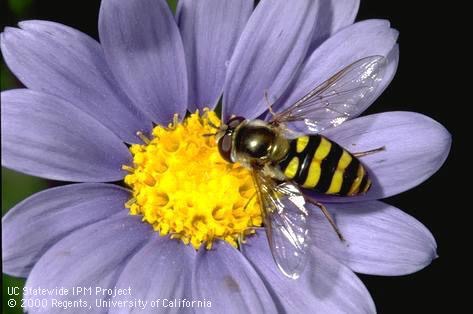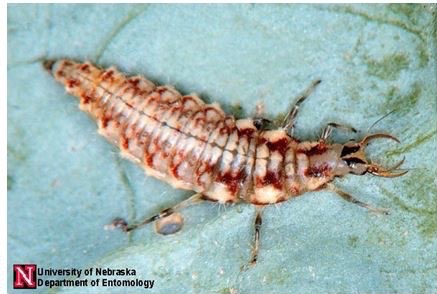
Get to know beneficial insects and their larva (good bugs) that live in your garden. Become familiar with their appearance and what flowers and plants they find attractive. “Good bugs” do not eat flowers and leaves, they prey on destructive insects, considered “bad buds”, and their larvae, and they will help to keep your garden in balance without the use of insecticides.
An important beneficial insect is the syrphid fly. It resembles a bee and is sometimes called a sweat bee or hover fly. It darts about sipping nectar from garden flowers. Its larvae are important predators of thrips, mites, scales, and aphids.

Parasitic wasps comprise many species from nearly microscopic to 3/4 inches long. Parasitoids are insects that kill their hosts by laying eggs on their host. The larvae then feed on it, killing it. The braconid wasp lays eggs on tomato hornworms, as well as on, or in, the bodies of aphids, cabbage loopers, and whitefly larvae. Look closely at the hornworm on the left and you’ll find a tiny wasp emerging from eggs that are living on the worm.

Lacewings, tiny flying insects with white “lacy” wings, and lady beetles are two easily identified examples of beneficial insects that control “bad bugs” while in the larval stage, and to some degree in the adult stage. Lacewing larvae eat aphids, thrips, mites, mealybugs, caterpillars and other soft-bodied insects. The convergent lady beetle (commonly called ladybugs) has a voracious appetite for aphids, especially in the larval stage of development. In their lifespan of about a year, ladybugs can eat 5,000 aphids. Their larvae resemble a ½ inch spiny black “alligator” and they can attack and devour aphids at a remarkable rate.

There are many other beneficial insects, called parastoids, that prey on bugs. The minute pirate bug, spiders, fungus gnat predator, and beneficial nematodes play large parts in keeping your garden in balance. Encourage these “good guys” by planting plants that will attract them – trees, shrubs, and especially flowers.

Plant flowers that allow easy access to nectar. Generally, the same plants that attract parasitoids will nourish lacewings and ladybugs as well. Plant sweet alyssum, cilantro flowers, yarrow, carrot, celery, chervil, dill, fennel, lovage, parsley, as well as sunflowers, marigolds, zinnia, aster, and daisies. Attract beneficial insects to your garden and perhaps they’ll stay for lunch!
For a complete list of of predator bugs, parastoids and insects they control go to the UC Davis website.


Comments
Comments are closed.